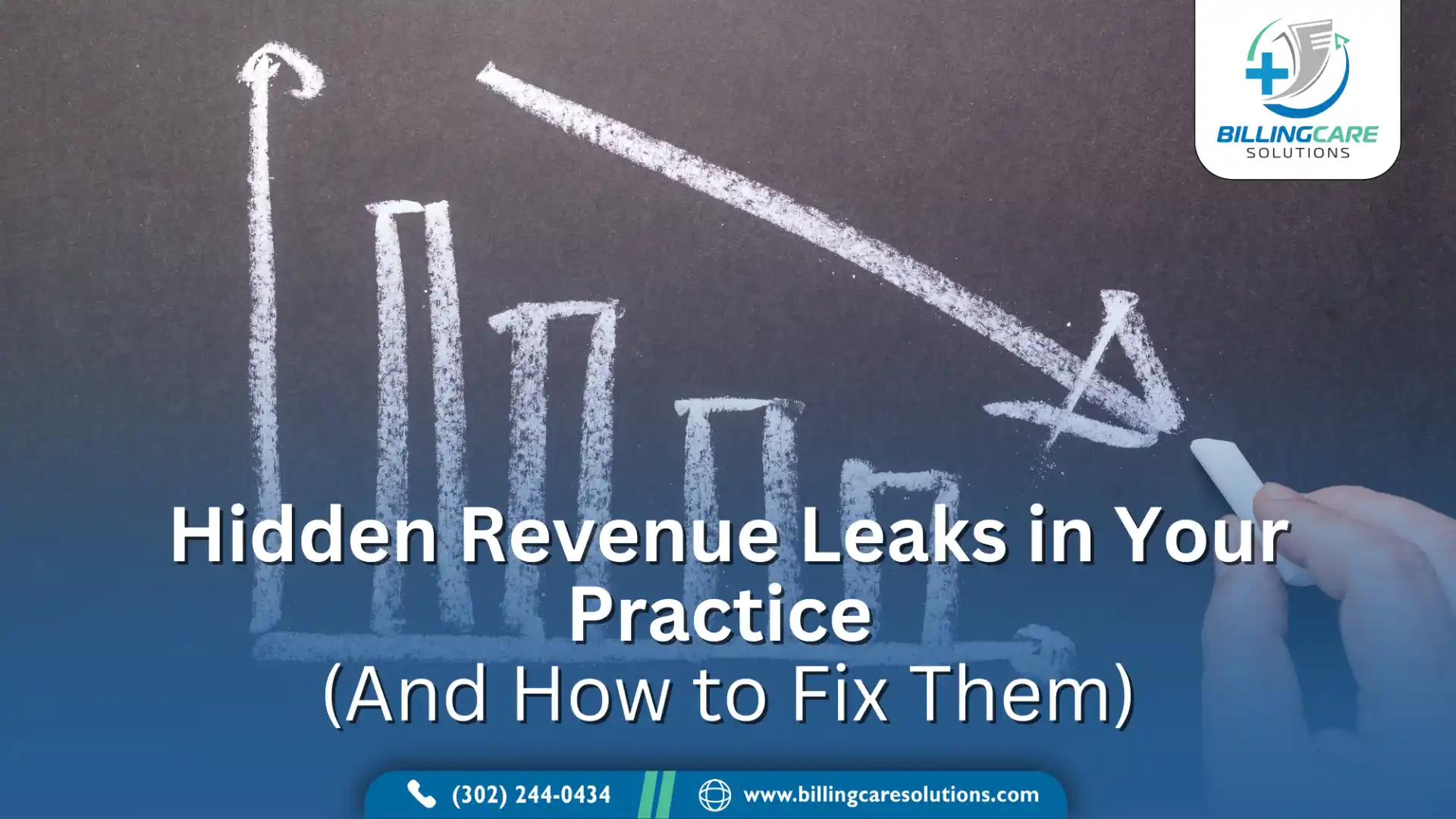Hidden Revenue Leaks in Your Practice
MDiscover common hidden revenue leaks in medical practices and learn how to fix coding errors, claim denials, and billing gaps to improve collections and profitability.

Every healthcare practice, regardless of size, faces the risk of hidden revenue leaks—subtle coding mistakes, delayed claims, or administrative oversight that quietly drain income. At Billing Care Solutions, we help you identify and plug these leaks to maximize profit and operational efficiency.
Why Practices Overlook Revenue Leak Issues
Busy medical staff often prioritize patient care over administrative details. Without expert oversight, small inefficiencies—like unbilled visits or repeated denials compound over time, leading to significant financial loss.
Common Types of Hidden Revenue Leaks
a. Coding and Documentation Errors
Using outdated or incorrect CPT/ICD codes leads to underbilling or rejections.
b. Untimely or Missed Claims Submission
Delays or omissions in claim submission reduce reimbursements and can violate payer rules.
c. Underpayments and Downcoding
Payers may undervalue services. Without monitoring, these underpayments go unchallenged.
d. Claim Denials and Rejections
Denied claims due to missing documentation or lack of pre-authorization often go unappealed.
e. Patient Billing Gaps
Mistakes in posting co-pays or balances cause write-offs instead of collections.
f. Insurance Eligibility Issues
Unverified or expired insurance results in non-payment or patient responsibility shifts.
g. Uncollected Co‑Pays and Balances
Untimely patient billing follow-up leads to lost revenue.
h. Inaccurate Fee Schedules
Failing to regularly update charge master to market and payer changes.
i. Inefficient Revenue Cycle Processes
Lack of automation delays key RCM tasks and increases AR days.
j. Contract Mismanagement
Unrealized contractual concessions or failure to audit payer terms.
How Hidden Revenue Leaks Impact Your Bottom Line
A practice losing just 5–7% of total billings can see an overall revenue drop of 20–30%, affecting investments, staffing, and patient experience.
Signs Your Practice May Be Losing Revenue
- Decreased Net Collections despite same volume
- Rising Denial Rate (>10%)
- AR Days > 45 days
- Frequent patient billing complaints
Root Causes Behind Revenue Leak Vulnerabilities
Issues often stem from inadequate staff training, outdated software, missing audit protocols, or insufficient reporting and analytics.
Audit vs. Analysis: Where to Start
A full Revenue Cycle Management (RCM) audit especially one offered by Billing Care Solutions, evaluates every phase, from pre-registration to final collections.
Step‑by‑Step Process to Identify Hidden Leaks
- RCM Audit – Review workflows, denials, and performance metrics.
- Coding/Documentation Review – Ensure correct CPT/ICD pairing.
- Analyze Denial & AR Patterns – Pinpoint systemic issues.
- Patient Account Reconciliation – Make sure all patient charges are posted!
Technology and Tools That Pinpoint Revenue Loss
- Automated claim‑scrubbing tools catch errors pre-submission.
- Eligibility verification software prevents insurance rejections.
- Robotic process automation (RPA) reduces manual tasks.
Best Practices to Plug Revenue Leaks
- Ongoing staff training (e.g., coding, compliance updates).
- Use of standardized documentation templates.
- Dedicated claims follow-up teams to handle denials.
- Frequent fee schedule and contract audits.
- Negotiations with payers for fair reimbursement terms.
- Transparent patient communication on fees and billing.
Billing Care Solutions’ Proven Approach
We combine:
- Custom Revenue Leak Assessments
- Claim scrubbing & denial management
- Clear, actionable reporting and dashboards
- Ongoing support to ensure compliance & optimization
Case Study: Practice Recovers 15% Lost Revenue
A mid-size cardiology clinic partnered with Billing Care Solutions, uncovering $250K in underpayments and denials. Within six months, they recovered 15% of lost revenue, boosting collections and patient satisfaction.
ROI of Plugging Hidden Revenue Leaks
For every $1 invested in auditing and denial management, practices typically recoup $3–5 in recovered revenue, with even greater returns long term.
How to Start with Billing Care Solutions
- Schedule your free Revenue Leak Assessment
- Review customized audit report
- Implement recommended fixes
- Monitor progress via our dashboard
10‑Point Revenue Leak Prevention Checklist
- Conduct quarterly RCM audits
- Regular code and documentation training
- Automated eligibility verification
- Daily claim scrubbing
- Weekly denial follow-up
- Monthly fee schedule reviews
- Bi‑annual contract negotiations
- Daily patient posting
- Monthly AR analysis
- Real‑time revenue dashboard
Tools & Resources for Ongoing Monitoring
- RCM KPI dashboards
- Claim denial tracking software
- Eligibility & pre-authorization systems
- Fee schedule benchmarking tools
Scaling From Small to Multi‑Provider Practice
As practices grow, complexities multiply. We provide scalable RCM solutions aligned with your provider count and specialties.
The Role of Outsourcing in Leak Prevention
Outsourcing allows access to specialized teams, reduces overhead, and increases focus on core care functions.
Staying Current: Regulatory & Coding Updates
Frequent policy changes (e.g., ICD‑11, telehealth codes) require vigilant updates to maintain revenue integrity.


